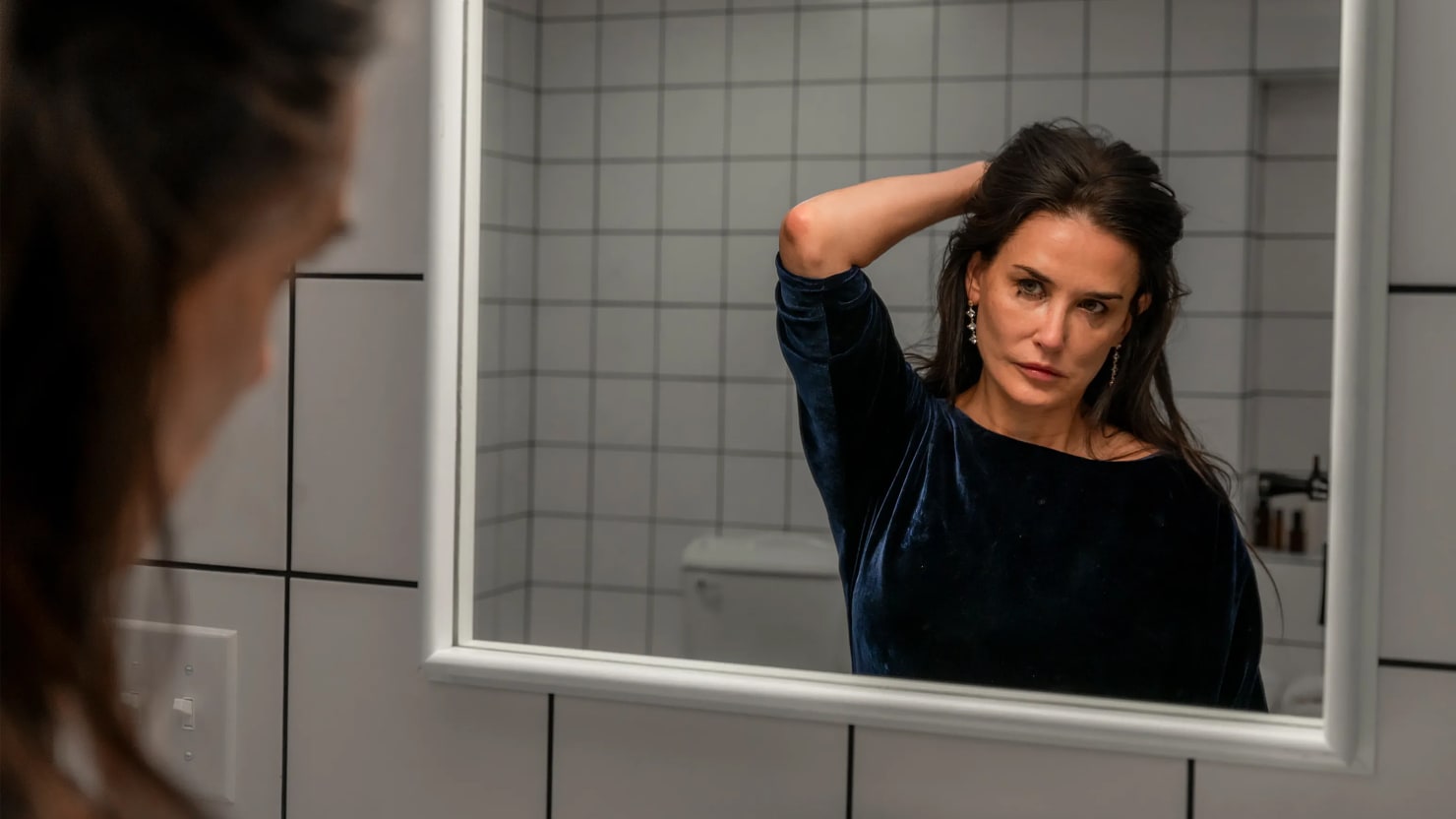Grotesque and sexy in hilariously outrageous ways, writer/director Coralie Fargeat’s The Substance is a squishy tale of one woman’s war against the ravages of time. Indebted to the work of David Cronenberg, Brian De Palma, and, most self-consciously of all, Stanley Kubrick, this body horror shocker is neither subtle nor concise when it comes to its themes or its phantasmagoric nastiness.
Nonetheless, like a band latching onto a tasty riff and deliriously riding it into the ground, this genre jaw-dropper—premiering at the Toronto International Film Festival on Sept. 5 and in theaters on Sept. 20, following its win for Best Screenplay at May’s Cannes Film Festival—pushes everything past the point of moderation and decency until it becomes a riotous discourse on the personal and cultural forces that drive women to madness in search of physical perfection.
Spearheaded by literally and figuratively revealing performances from a fantastic Demi Moore and Margaret Qualley, The Substance is a study of Elisabeth Sparkle (Moore), a TV exercise queen who, after spending her 50th birthday taping her hit program—think old-school Jane Fonda workout vids in which hotties do synchronized routines in spandex—overhears her network boss Harvey (Dennis Quaid) slander her as a haggard “old b—h” and demand that she be replaced.
At a subsequent lunch, Harvey tries to let Elisabeth down by telling her that “renewal—it’s inevitable.” Rebirth is certainly coveted by the fading icon. An amusing opening sequence depicts the decaying lifespan of Elisabeth’s Hollywood Walk of Fame star, and when she stares in the mirror, the look of disgust and dismay in the former Oscar winner’s eyes is unmistakable.
Driving home, Elisabeth is distracted by the sight of her face being torn off a billboard and gets into a car accident. At the doctor’s office, a physician’s assistant surreptitiously checks her out and announces that she’d be a “good candidate.” While exiting, she’s confronted by an old classmate who praises her still-vibrant loveliness. Alas, she remains consumed by diminishing self-esteem, and is thus intrigued when she discovers that the physician’s assistant has slipped a USB drive into the pocket of her bright yellow coat. This device is labeled “The Substance” and boasts a phone number, and upon returning home, she checks out its contents, which concern a revolutionary cellular-division process that guarantees “a better version of yourself.”
Elisabeth initially balks at this nonsense but her wrinkle-related insecurities won’t leave her be and she soon contacts the service. This earns her a key card that grants her access to a scary alleyway address where she finds a mailbox with a package containing instructions and equipment for The Substance. The first step is to inject herself with an activator. Next, she’s supposed to use liquid IV food dubbed a “stabilizer” for seven straight days—as is her “other self.” Finally, at the end of the weeklong period, she’s supposed to “switch.”
Gazing in the mirror in the nude, Fargeat’s camera lingering over every saggy crease and crevasse in her face, hips, legs and ass, Elisabeth takes the leap and sticks herself with the mystery compound. She promptly hits the tile floor, her pupils doubling and her back splitting open so a new being can emerge from within.
That figure is Sue (Qualley), her younger, better doppelganger, who’s everything Elisabeth dreamed of being. “Remember you are one,” says the voice on the end of the phone, but Sue views herself more as Elisabeth 2.0, and swiftly sets about creating the life that her other half desired, complete with a starring role on an exercise show that’s notable for its skimpier outfits and more sexualized content.
Operating in a heightened The Twilight Zone-ish vein at the same time that it overtly shouts out to The Shining and 2001: A Space Odyssey, The Substance dramatizes its action with one extreme, drooling close-up after another, many of them fixated on flawless skin and perfectly sculpted butts. In doing so, it objectifies to both prove the allure of youth and attractiveness, and to caustically damn our eternal obsession with them—a censure that pinpoints men (via Harvey and the unseen Substance mastermind) as co-creators and peddlers of these toxic beauty standards.
Given that Sue is a pure, idealized form of Elisabeth, it’s predictable that she not only craves the limelight, but is eager to exploit her good looks and sex appeal to seize it. The problem, however, is that at the end of each seven-day period, the duo must flip-flop between being animated and inanimate—a process facilitated by Sue’s construction of a secret room where they can lay undetected during their slumbering week.
The Substance’s hyper-real action is at once dreamy and gnarly, not to mention obvious; Fargeat plays every note big, bold, and unambiguous. Consequently, there are stretches during the film’s 140-minute runtime when it dawdles, working its way through twists and turns that are foreseeable from a mile away. Though never sluggish, it invariably feels distended.
Fortunately, Moore and Qualley are exceptional as two halves of the same narcissistic and fame-hungry whole, exuding imperious and overwhelming eroticism that’s laced with foul desperation and insanity. The Substance manages to simultaneously titillate and decry such titillation without ever affecting a scolding tone, and as Sue becomes increasingly possessive of her awake time—and resentful of Elisabeth as the ball-and-chain holding her back from fulfilling her ambitions—the film becomes squelchier and sicker, to its great benefit. Mutation reveals the dark, corrupted heart of these conjoined beings, and the director doesn’t skimp on icky, gooey, bloody monstrousness, all of it embellished with vaginal and penetration-related designs and imagery.
Gazing at Moore and Qualley’s nude frames with an intensity—alternately admiring and disapproving—that echoes the protagonists’ own self-critiques, The Substance acknowledges the pull of surface splendor in order to eviscerate contemporary beauty culture. There’s no mistaking what it has to say, sometimes to its detriment, and yet its out-there impulses are spot-on, right through to a third and final chapter that chooses to re-hammer home its points in ever-crazier fashion. Dialing it up to 12 when 10 would have sufficed, it exhibits a genuine gonzo spirit that reveals the true ugliness of vanity.




![Tyson Foods Plant [Photo: Food Manufacturing]](https://southarkansassun.com/wp-content/uploads/2023/08/iStock_1185520857__1_.5e441daa51cca-600x337.jpg)








![Silverado Senior Living Management Inc. [Photo: Los Angeles Times]](https://southarkansassun.com/wp-content/uploads/2023/10/download-6-4-600x337.jpg)

![China's Wuhan Institute of Virology [Photo: Nature]](https://southarkansassun.com/wp-content/uploads/2023/09/d41586-021-01529-3_19239608-600x337.jpg)















